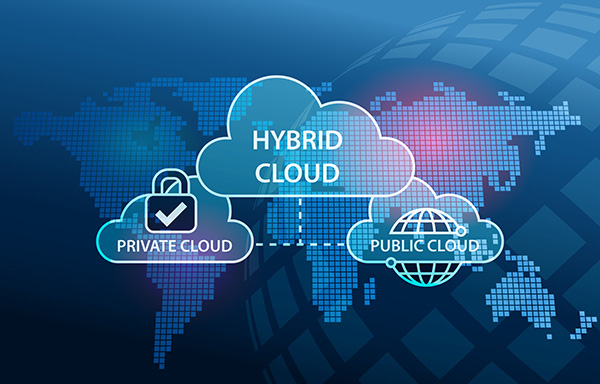Modern cloud technologies are among the most powerful and sophisticated pieces of human creation ever made. The introduction of powerful cloud services like cloud computing and cloud storage from the likes of Amazon AWS, Microsoft Azure, and Google GCP have made it possible for various industries to reach new technological heights. Such feats of technical marvel are not possible without some complexity on the cloud’s technical side. A big example of such complexity includes strategies to integrate multiple cloud services into one mighty one.
Revenue from increasing public adoption of cloud, according to Forrester, will be one of the main aspects of pandemic recovery for enterprises. The research found that enterprises will find their savior in public cloud infrastructures, enabling them to build and deploy applications and keep workers connected globally quickly. At such a crucial time, larger enterprises with massive storage and distributed computing need to utilize multiple cloud infrastructures. All of these cloud services are finally integrated to form a hybrid cloud strategy.
This article takes you through the term hybrid cloud and all there is to know about it. It will discuss how enterprises form a hybrid cloud strategy and what are some of the popular options. Some of the main challenges this strategy faces will also be evaluated, as the hybrid cloud can bring in more complexity and more power and rigor.
What Is Hybrid Cloud Computing Exactly?
Most enterprises employ a single public or private cloud infrastructure for their needs. Public cloud infrastructure is available over the internet and not owned by any particular owner. Public cloud services can be utilized on a subscription or pay-as-use model. A private cloud infrastructure, however, is owned by the user and tailored as per their needs. It offers greater control over the data and resources of the cloud.
By adopting a hybrid cloud approach, enterprises integrate multiple (public or private) cloud infrastructures. The ‘hybrid’ in the name comes from the fact that the approach uses the advantages of the different infrastructures involved. An example of a hybrid cloud strategy could be an enterprise connecting its private cloud services that hosts all its relevant data with a public cloud service instance. Such a step could be to analyze better and manage that data.
The concept of hybrid cloud is further extended to create the ‘hybrid multi-cloud architecture.’ It refers to a set architecture that comprises multiple cloud services that are integrated instead of each acting separately. With hybrid multi-cloud, enterprises experience simplified workload mobility and much more advantages than using clouds as just backups.
Why Is Hybrid Cloud Computing Getting Popular?
The hybrid cloud approach is witnessing a surging rate of adoption in the industry. According to Forrester, 59% of North American and European enterprises have a hybrid cloud as their cloud strategy. Further research by Forrester found the hybrid cloud to be the most popular form of infrastructure-as-a-service (IaaS) among enterprises. These researches show an already present wide acceptance for hybrid cloud, along with an indication that it is growing strongly.
The insistence on the hybrid cloud by enterprises is due to the significant benefits it has to offer. According to IBM, a full hybrid, multi-cloud platform approach brings in as much as 2.5x the value offered by a single cloud approach. Some of the main advantages that come with adopting a hybrid cloud strategy are as follows:
Tangible Business Benefits
The cloud strategy of any enterprise is closely derived from their business objectives and their resources. By including a hybrid cloud into the cloud strategy, enterprises see better returns for their investment in better data management, improved security, and better flexibility. It also enables quicker application development and deployment to ensure customer satisfaction. Therefore, adopting a hybrid cloud gives enterprises a competitive edge by providing them better business benefits.
Integration
With a hybrid cloud implementation, you can locate applications as needed. Data silos can be easily avoided, and data can be placed to optimize the data transfer, processing, and obtaining insights. By integrating the cloud services you opt for as needed, you get to decide which critical data remains secure in an on-premise facility and which can be relocated as needed.
Best Environment for AI
Research by Forrester has found a hybrid cloud environment to be the most preferred for AI development. Enterprises use a mix of cloud and non-cloud technologies for different parts of the AI application lifecycle. Most enterprises preferred a hybrid cloud for the cloud part for aspects of the lifecycle like development, testing, and production. The inclination towards hybrid cloud technology for AI/ML development comes from better performance and decreasing implementation time.
Cost
One of the major benefits offered by a hybrid cloud strategy is the cost-saving that accompanies it. With hybrid cloud, you get to witness better overall IT cost management and overall better compute and storage costs. The cost-saving comes because the strategy employs the different cloud services as per their strengths.
Challenges Faced With Hybrid Cloud Computing
While hybrid cloud strategy provides significant benefits, it is still an emerging technology. There are many facets of it that enterprises still struggle to get right. The challenges with hybrid cloud are somewhat expected as it involves integrating different cloud services, often from different vendors. With such complexity, some complications are bound to emerge but can be easily dealt with.
Most enterprises felt security to be one of the biggest concerns when working in a hybrid cloud environment. As sensitive data moves between different cloud services, the final integrated system needs to have a robust security profile. Most enterprises complain of insufficient security infrastructure when using a hybrid cloud environment for AI development. Ensuring security often turns out to be one of the major costs of maintaining and running a hybrid cloud strategy.
Cloud migration is another major challenge when using the hybrid cloud approach. With multiple cloud services, data migration can seriously affect efficiency. As an enterprise’s cloud usage increases, application reconfiguration and reworking are major challenges. It often takes up significant resources before even showing any of the promised benefits.
However, many helpful practices ensure that such challenges are mitigated easily. For example, deciding on a cloud strategy, latency, cost, and data gravity should be the prime deciding factor. When eventually deciding on a hybrid cloud strategy, enterprises should research the best partners for the cause and collaborate accordingly.
Final Thoughts
As we saw, a hybrid cloud strategy is a potent cloud strategy that can bring in great benefits when implemented smartly. The article discussed the various benefits it has to offer and the challenges that come with it. Hybrid cloud infrastructure is an increasingly popular cloud strategy. After all, research suggests that the cloud market will witness an 18% growth in just the next two years.

 Emad Bin Abid
Emad Bin Abid




